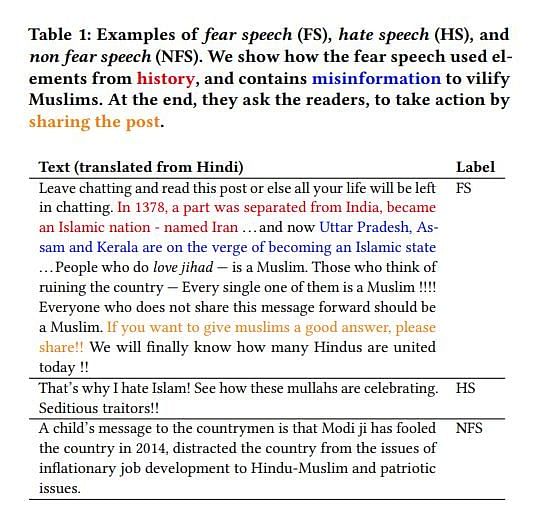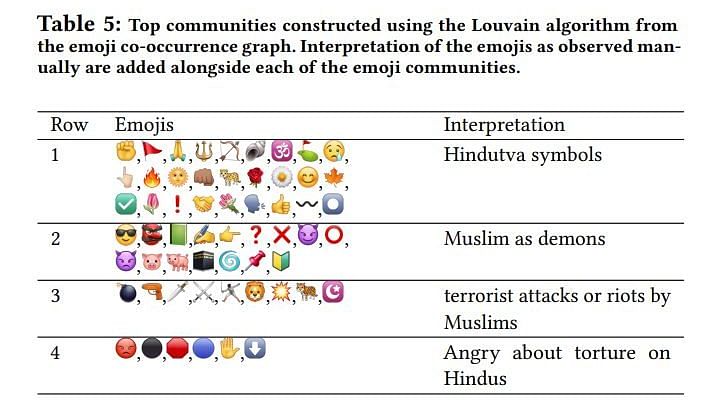New Delhi: It’s not as toxic in language, doesn’t employ derogatory keywords, and might be the new tool of choice for social media users as they look to buck hate speech laws. Introducing “fear speech”, a subtle form of hate speech that often relies on emojis and is apparently catching on in India.
A study by researchers from IIT-Kharagpur and MIT Institute of Data, Systems and Society, US, suggests Indian WhatsApp users are using fear speech to incite readers against targeted sections.
The study, for which the researchers pored over more than 5,000 political, public WhatsApp groups, was published on the pre-print portal arXiv.org earlier this month. It is titled, “Short is the Road that Leads from Fear to Hate: Fear Speech in Indian WhatsApp Groups”.
The researchers sought to “particularly focus on understanding the dynamics of fear speech against Muslims in the public WhatsApp groups”, and found in an accompanying survey that users who post fear speech are “significantly” more likely to support the BJP.
Also read: ‘Hate speech repudiates right to equality’ — Full text of SC judgment in Amish Devgan case
What is fear speech?
Fear speech, the researchers note, may seem similar to hate speech, but is different. It quotes a definition devised by Antoine Buyse, a professor of human rights at Utrecht University in the Netherlands, to describe it “as an expression that attempts to instill a sense of fear in the mind of the readers”. This is different from hate speech, which seeks to provoke hatred against a group.
Presenting an example of a message classified as fear speech, it says the post portrays “the Muslim community as a threat, thus creating a sense of fear in the minds of the reader”.

In an email to ThePrint, Buyse cited his own research to say that while hate speech may pave the way for violence, “it is fear speech that is a much stronger indicator of impending violence…”
“The instigation of fear among one’s own group, rather than hatred against the other, has been found to be a key mechanism in such processes leading to violence,” he said.
Fear speech, the researchers note in the study, may also be used to evade punishment for hate speech while creating fear. “Due to the strict laws punishing hate speech in India, many users refrain from a direct call for violence on social media, and instead prefer a subtle ways (sic) of inciting the readers against a particular community,” they add.
How the research was carried out
To identify WhatsApp groups for the study, the researchers say they took the help of political journalists to shortlist keywords related to politicians and political parties. They then used the keywords to find public WhatsApp groups via Google, Facebook, and Twitter.
The keywords, they say in the study, “cover all major political parties and politicians all across India in multiple languages”.
The researchers subsequently gathered 2 million posts — texts, images, videos and audios — dated August 2018 to August 2019 from over 5,000 groups thus identified. The next stage was manually curating a dataset that had around 8,000 posts considered fear speech and around 19,000 considered non-fear speech.
Explaining why they focused on fear speech against Muslims, the researchers say in the paper that “India is one of the 14 countries where religious minorities are constantly under attack” and that “most of the religious conflicts are between Hindus and Muslims” such as the conflict over the Citizenship Amendment Act (CAA).
The Act was yet to be passed by Parliament in the period the messages were drawn from.
Also read: Facebook turned blind eye to BJP leader’s hate speech to protect its business, says WSJ report
What the study found
The paper notes fear speech messages are shared more widely compared to non-fear-speech messages.
As many as “52 per cent of the fear speech messages had at least one emoji present in them”, it adds. The paper includes a section where different emojis are listed to explain their possible interpretation.

Fear speech topics targeting Muslims attempted to “promote negative thoughts”, the researchers say. Examples cited include “love jihad”, “Muslim exploitation of Dalit”, and “Islamisation of Bengal”.
To “characterise” the people behind such messages, the researchers also conducted a survey among some users they identified as having posted fear speech.
As part of the survey, the researchers sought respondents’ opinions on the citizenship law and the emergence of the Nizamuddin Markaz as a Covid-19 hotspot in the early days of the pandemic. The questionnaire included optional questions about gender and political party supported by the respondent.
The paper says there is “clear evidence” that users who posted fear speech messages themselves “are significantly more likely to support the Right-wing party in power (BJP), blame Muslims for the Covid-19 hotspot in Nizamuddin Markaz, and to support the Citizenship Amendment Bill (sic)”.
Also read: ‘We are open & non-partisan, know work on hate speech is never over’ — Facebook India head




IIT is also anti hindu and Anti NAtional LOL. The people who are taking about other side is very small in number. I think Hindus here think they are the best top and rest are terrorist and rice bag. only 1/3 of worlds population is humans rest are rice bags and terrorists. If you treat everyone else like this. dont except good from others. if it continues like this hindu will become mini islam.
Muslim behaviours are disliked by all and not just Indians. There are plenty of examples across the globe.
As a PhD scholar from one of he world’s top 20 universities in Australia, I can say this study is FLAWED, the design of study itself is biased, hence its results are biased, study itself is designed to be a hinduphobic study and likely has abrahmic (more specifically muslim) researcher and sponsors, this is evidence from the banal and innocent emoticons used as symbol of hate speech, and outright HATE SPEECH against Modi and BJP (targetting them only because they are Hindus). Hindus and India are the victim of islamist invasions, genocide, cultural genocide, millions of forced conversions, rape, pillage, forced and sold into slavery, etc. Research without context is wrong. This research is outright HINDUPHOBIC research, total rubbish research. Shekhar Gupta has gone rogue and needs to be fixed by GoI for keep publishing rubbish without scrutiny an d fact check.
Lmfao ! This is the most lopsided “research ” I have seen ..the so called method to “inflintrate ” whatsapp …what about one check out whatsapp of other side …they use words such as gobar ,gomutra ,cowpiss drinker casually for Hindus ,secondly it has become a habit to target hindus using hindutva as camfalouge
One more Anti Hindu study by Leftist gang, No value